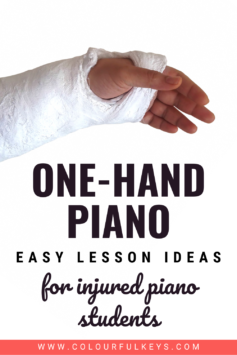
This blog post about one-hand piano teaching for injured students was written by Carmen Carpenter. Carmen has taught music in a school setting as well as in her home studio for more than 30 years. Teaching combines two of her favourite things: music and kids! Besides teaching music, Carmen loves spending time with family playing games, working puzzles and watching movies. She’s also an avid reader and loves taking long walks on her local, woodsy trails.
Tell me if you’ve experienced this dreaded phone call, email or text: “Hey, just wanted to let you know that Joey broke his arm this weekend. He’ll be in a cast for [insert dire number here} weeks. I guess we’ll have to put piano lessons on hold. Sorry!”

For most families, a broken arm or wrist brings many activities to a standstill. But I have good news for you: Piano lessons do NOT have to stop just because a child has an injury to their arm, hand or fingers.
Still, it can be challenging to plan one-hand piano lessons for injured students, not to mention keeping them motivated to practise at home. Here are some tips to help you navigate the murky waters.
Motivate With Music
Practising with one hand can be quite discouraging for a student. Simply assigning one hand of a piece or doing scales or technique exercises with the uninjured hand could get really boring, really fast.
Keep the recovering student engaged and inspired to practise by choosing music that is properly levelled, uplifting and – of course – fun.
One-Hand Reading Repertoire
If you do a “one hand only” piano music search on your favourite sheet music site, you’re likely to find quite a few possibilities. Some of the suggestions will be “meh”, but many will be great.
Here are just a few tried-and-true options at all skill levels to jump start your search.
- Piano Pronto offers quite a few one-handed solos for primer students – intermediates.
- This set of one-hand pieces from Diane Hidy can be great for injured late beginner piano students.
- The newbie – beginner levels of methods like Piano Safari have one-hand pieces baked in for all students, not just the injured ones.
- Intermediate – early advanced piano students will love this free music from Stephan Beneking, who’s written over 150 one-hand pieces just perfect for injured students.
If you’re a member of Vibrant Music Teaching, remember to use your exclusive discount code when ordering from Piano Safari.
Resourceful Rote Pieces
Many rote pieces could be adjusted to suit playing with one hand or the other. And because note reading isn’t required, students can continue to work on those often-neglected elements like articulation and expressiveness. Check out these wonderful collections of rote pieces:
- BlitzBooks by Samantha Coates
- ‘Little Gems for Piano’ by Paula Dreyer
- The Rote and Reading® series from Wendy Stevens
If you’re a member of Vibrant Music Teaching, remember to use your exclusive discount code when ordering from BlitzBooks.
Dynamic Duets
Whether you teach your students one-on-one or in some sort of a buddy system, capitalise on the one-hand only season by including lots of duets with your injured piano students. There are many ways this can materialise.
- Try duet improvisation, with one person playing a chord progression and the other improvising over it. If you’re not super confident with improv, the Vibrant Music Teaching Library has loads of improv resources to walk you through it step-by-step.
- Play the teacher accompaniment parts included in many primer – late beginner method books.
- Have the injured student play one clef while the other player tackles the other clef.
Not sure how to find the perfect duet resource? Enter your info below and we’ll send you our ‘Duet Pathway’ to help you sequence fantastic evenly-levelled duets, many of which can be tailored to fit your one-hand piano needs.

Subscribe to updates and get Duet Pathway
Enter your details to subscribe to the newsletter for piano teachers with information, tips and offers.
I hate spam as much as you do! I’ll only send you information that’s directly relevant to music teachers and you can unsubscribe at any time.
VMT members can download ‘Duet Pathway’ directly from the Printable Library. Not a member? You wouldn’t believe what you’re missing! Take a tour to learn more and join today at vibrantmusicteaching.com.
Prioritise Other Elements of Musical Learning
Recuperating from an injury is a fantastic time for you to focus on those elements that you might not always have time for. Consider adding these things to your students’ lessons and practice assignments:
- Theory or other written work
- Music history
- Sight singing with solfa
- Composing
- Active listening
Luckily for you, the VMT Library is chock full of resources to help you plan lessons and home assignments in all of these exciting areas of music.
Get Real About Practice Expectations
Piano practice can be exhausting and overwhelming with two strong, healthy hands. Take one of those hands away and practice time can be downright demoralising!
Easy Does It
Be sensitive with students who are recovering from injury. Of course you should expect them to keep practice going, but give them clear guidelines on what constitutes a productive practice time, and give the injured student realistic assignments with these 2 factors in mind:
- Since they have only half of their usual functionality, there may be times when it’s appropriate to cut their actual playing time in half while healing. If that’s the case, be sure you communicate that expectation to their families, as well.
- If appropriate, make it clear that it’s normal and acceptable to have half (maybe even less) of the student’s usual output.

Need more help structuring one-hand piano lessons for injured students? You’ll love the resources in Nicola’s ‘Planning Lessons’ hub page.
Quality Over Quantity
I imagine that most of us prefer our students to have quality practice sessions whether they’re using 2 hands or 1. But for students who like to zoom through their method book, slowing their progress by half can feel like a huge setback.
If the student’s only able to master one piece during their recuperation period, applaud their efforts and persistence in continuing to practise.
Besides pieces, encourage your student to become proficient in practice strategies that they tend to ignore when they’re easily rolling through their two-handed pieces. I like to use the ‘Practice Plays’ and ‘Practice Hero’ from the VMT Library to add a dash of fun to the process.
There’s no reason piano lessons have to stop dead in their tracks simply because piano students are injured and need a one-hand approach.

What do you do when a student can only play with one hand?
Tell us about it in the comments below.